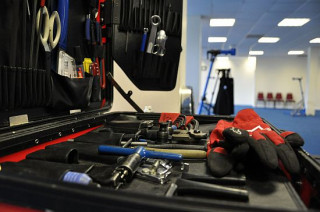Looking after your chain and the other transmission components that come with it - chain-rings, sprockets and jockey wheels - can be a contentious area within cycling with firmly held beliefs and long established ‘folklore' about the way it should be done. I'll try to be pragmatic with my advice and stick to what I believe to be good practice based on engineering principles and experience.
Changing times
In an ideal world where we were only concerned with long transmission life we would completely contain the chain in an oil rich environment - with the dirt kept out. This approach was popular at one time with Sturmey Archer hub gears and a fully enveloping chain ‘bath' - but this was used on bikes primarily for commuting and touring. Thesedays most of us are more concerned with keeping the weight of our bike down and our expensive gear changing mechanisms on show - in order to keep it running efficiently and enhance its useful life. How do we do that? The answer is simple - keep it clean and lubricate it well. This sounds a simple process too but can be contradictory when the lube acts as a dirt-magnet...
A few tips...
1. Clean your chain often and well - I tend to leave the chain in situ on the bike and use plenty of good quality degreaser to get all the dirt and old oil off. I often also use a chain cleaner tool which comprises internal brushes and a bath for the degreaser - Park Tools make a nice one. Often means after every ride.... Clean the ‘rings, jockey wheels and sprockets too. Wash the degreaser off and dry the chain before....
2. Lubricate the chain with a good quality bike-specific lubricant. The Tribologists (people devoted full-time to the science of reducing friction) have developed oils and additives which when used properly will make your drive-train more efficient and last longer. For wet conditions always use a ‘wet' lube and for dry conditions consider using a ‘dry' lube. Wet lubes penetrate the chain and get to the crucial roller/pin interface and stay wet resisting rain and mud intrusion to the chain - but they do attract dust (so wipe off any excess). In hot, dry conditions this can lead to a ‘paste' developing which can increase friction and wear - hence the importance of 1.
3. ‘Dry' lube reduces the attraction of dust by using a light solvent carrier to get the friction reducing additives into the chain - the carrier evaporating once it's done its job. But I'm told by Tribolology experts that the additives aren't as effective as wet lubrication so I tend to use wet lube all year round. In summer I spend a little more time wiping off the excess and a bit more care applying less in the first place.
4. Check your chain ‘stretch'. This isn't actually stretch but wear to the chain pins and internal surface of the roller willmake the chain longer - hence the term stretch. You'll need a chain checker to do this but they don't cost much. The simplest ones slot into the chain and measure 0.75% extension on one side (over the nominal original length) and 1.0% when flipped over to the other side. 0.75% extension means your chain is showing signs of wear - you should check out your local bike shop or the internet for a replacement. 1.0% means change your chain for a new one or you will also quickly wear out your chain-rings and cassette - a stitch in time saves... about £100.

Q&A
How do I apply the oil to the chain?
If you don't have a work stand handy - hold the bike upright with the rear wheel between your legs, rotate the left crank backwards with your left hand (holding the centre unless you have very long arms!), apply lubricant to the inner surface of the rollers with your bottle static and the chain moving. You need to apply enough lubricant to flow into the space between the rollers and the side-plates - and then hopefully it will get between the rollers and the chain-pins. Run the chain round a few times - I ride round a few meters and change up and down the gears to get some oil on the sprockets. Then wipe off the excess with a rag pulling the rag along each section of chain. Take care not to get lube on brake rims or discs - I don't use a spray for this very important reason.
Should I lubricate a dirty chain?
If you think you can get oil into the roller/pin interface without carrying some dirt and grit along with the lube then go ahead. Please let me know your technique and if you can perform any other miracles! If like me you can't do it - go to step 1 - clean the chain!
Should I clean a new chain?
No - it's already clean and very nicely lubricated. Add more lube and wipe off the excess if you like.
What oil/lubrication/oil should I use?
If you only buy one get a bike specific ‘wet' lube.





